Choosing Between The Various Types for Health And Taste
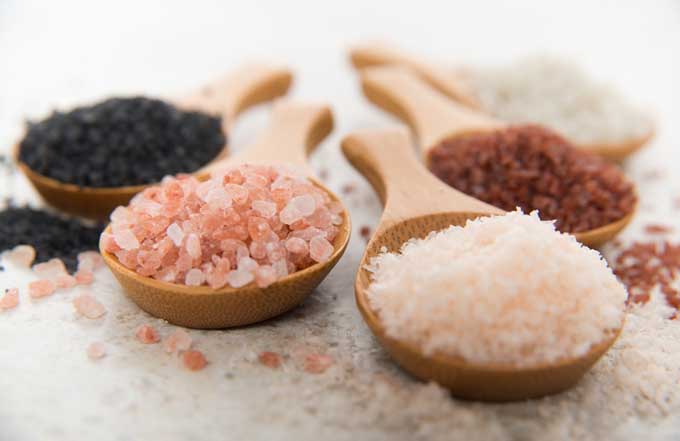
There’s so much to say about salt.
Everyone uses it, some abuse it. Your body needs it. Your brain runs on it. The heart shuns it. The tongue loves that taste.
But what is salt? Are there varieties that have a better flavor? Are there types that are more healthy than others?
What is Salt?
The crystals left behind after sea water evaporates are referred to as salt or sodium chloride. Most culinary salts are created in this way. The environment will affect the composition and color, which is why there are so many different varieties to choose from today.
Found virtually everywhere on earth and requiring no processing, this concentration of sodium will also contain traces of the minerals and other particles found in the environment around where it was formed. Variations in these compounds, such as the inclusion of calcium or magnesium, create unique varieties that may have differing tastes and/or hues.
Kitchen Salts
The common types found on your kitchen countertop or dining room table include granulated, coarse, kosher, or fine sea salt. The most common table varieties are generally harvested from underground mines. Once mined, the product is refined until only sodium chloride remains.
With most of the natural minerals removed, it lacks any additional benefits other than the sodium, which is actually necessary in certain amounts for your nervous system to function properly. This variety is available plain or iodized.
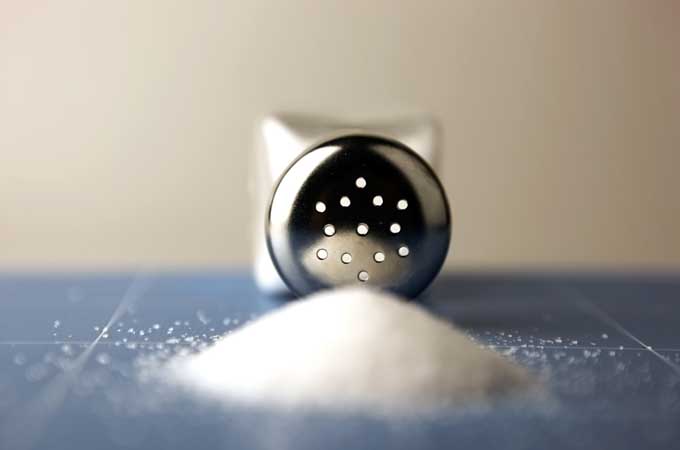
Iodized salt is created by spraying it with iodine. Manufacturers began iodizing sodium during the Great Depression when people started suffering from goiter, an enlargement of the thyroid gland caused by an iodine deficiency.
This is an unnecessary supplement if you have enough iodine in your daily diet. Seafood, dark green vegetables, and sea salt all contain natural iodine.
The common varieties found on your kitchen countertop are typically granulated, kosher, large grained crystals or fine sea salt.
The common granulated type is ultra processed, usually with the addition of iodine (the package will indicate whether it is iodized or not). It is very versatile and can be used in any recipe.
Large grained crystals make up the coarse variety. These salts are commonly found in grinders,which make it easier for you to enjoy them with just about any meal. The larger sized crystals make it easy to grind. Grind this variety over meat, fish, stews, and soups while cooking, or as a finishing condiment when a higher grade salt is not required.
Kosher
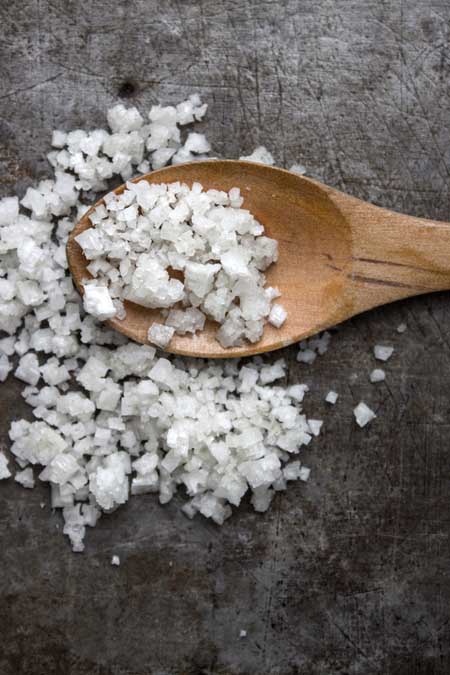
Kosher salt does not come from existing bodies of sea water, but rather, it is mined from dried up sea beds and oceans. It does not contain any additives or iodine.
The flake variety is not refined, but rather it is left to dry out on its own, and this type is known as the purest variety available.
Foodal recommends David’s Kosher Salt.
The large granules make it easy for you to grab a pinch to sprinkle onto your latest dish. The flakes dissolve easily and are milder than processed table salt. This variety is commonly found on the rims of margarita glasses and atop pretzels.
Condiment Salts
Finishing or condiment salts are comprised of a number of premier specialty varieties. They have personality. These examples are typically harvested by hand and are revered for their one of a kind textures.
This variety may be crunchy or soft, colorful or dull. The taste may be stronger than expected. They hit your taste buds with a burst of flavor.
Enhancing the punch of just about any dish from sweet to savory, these finishing varieties make the perfect garnish. The addition of this condiment adds a little something special to your finished dish.
Sea Salts
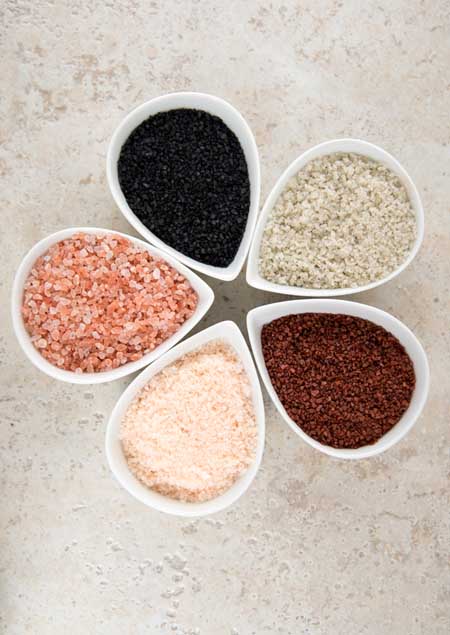
Sea salt is an unrefined type that’s harvested directly from seawater, using large clay trays. Then the sun and wind evaporates the water naturally, leaving sodium and other elements behind.
Since it is unrefined, it contains trace minerals such as magnesium, iron, calcium, manganese, potassium, iodine, and zinc. This type is harvested from the Mediterranean Sea, the North Sea, and the Atlantic Ocean (typically from France).
Salts formed when the oceans receded thousands of years ago are available in rock or coarse forms. Due to their size and the hardness of the crystals, they do not dissolve easily and may not be suitable for all of your recipes. These coarser varieties are better suited for dishes that have longer cook times, to allow them to dissolve completely.
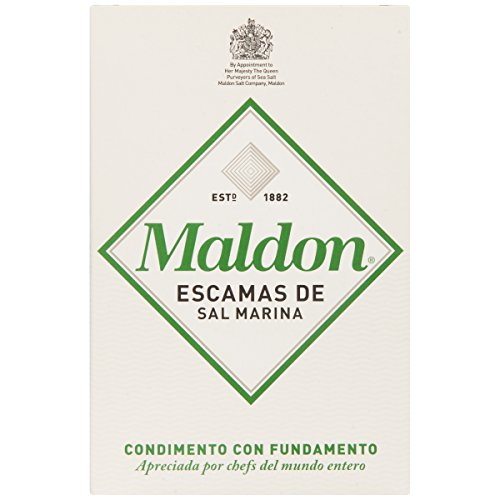
Foodal recommends Maldon Flaked Sea Salt. This is a family-run business whose traditional method of processing has remained largely unchanged since 1882.
Flake sea salt is light and delicate. It is naturally evaporated, producing a brine. This brine is then slowly heated until pyramid-shaped crystals form. This type is available in different flake sizes, from large to paper thin.
Flavored and smoked sea salts add a bit of excitement to your favorite dishes. These varieties add a unique twist to a wide assortment of recipes, including grilled and roasted meats, fish, and vegetables. They are available in fine, coarse, and flake grain sizes. Fine sea salt crystals dissolve easily, which makes them the perfect choice for all of your baking needs.
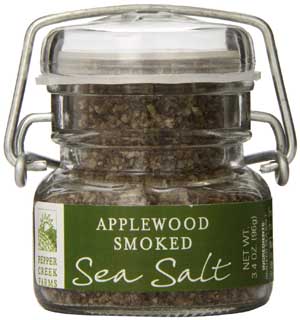
Foodal recommends Pepper Creek Farm’s Applewood Smoked Sea Salt to add an a bit of bite to your recipes.
French Sea Salts
French sea salts are harvested by hand from the Atlantic, using traditional Celtic methods. These crystals are carefully raked from the surface of salt evaporation ponds. Wooden tools are employed for this task, in order to preserve purity and produce a moist crystalline texture.
Since these varieties are not refined, they contain many of the naturally occurring trace minerals found in seawater. French sea salts add a delicious crunch to your favorite salads, cooked vegetables, and grilled meats and fish.
Fleur De Sel
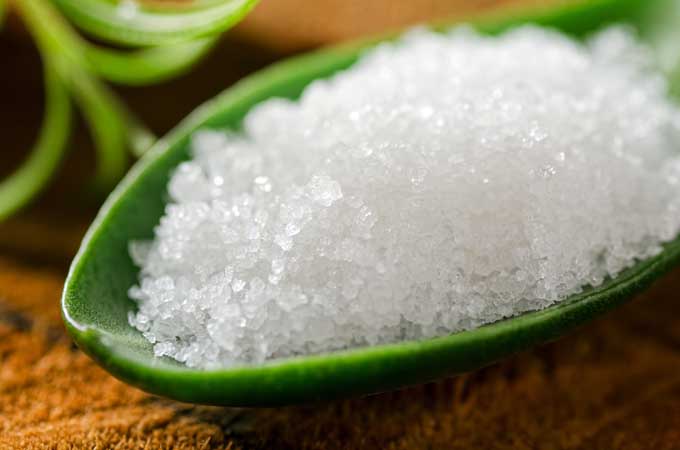
Fleur de sel is French for “flower of salt” and is highly regarded by chefs and foodies. This variety is considered to be a premier finishing salt. It is often referred to as the “caviar of salts” by chefs throughout the world. This variety is available as a coarse grain (perfect for finishing), stone ground fine (table salt), and extra fine grain (popcorn salt).

Le Saunier De Camargue’s Fleur De Sel Sea Salt is a very popular variety.
Sel Gris/Grey Celtic
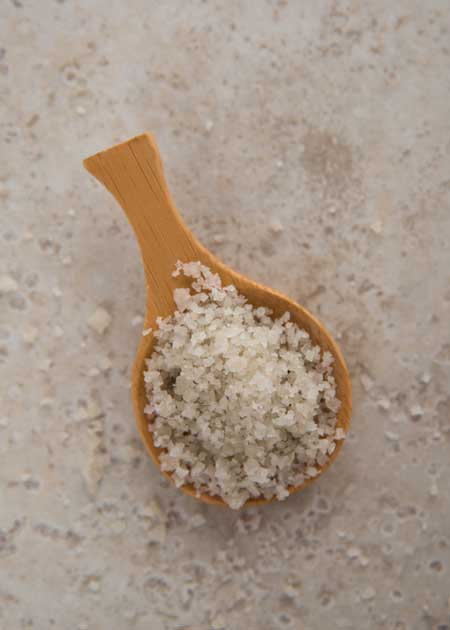
Sel Gris lies somewhere between a basic kitchen and a condiment salt, and the name is derived from its color. These unrefined moist crystals are found in France’s Brittany region, located on the Atlantic coast.
The light grey to purplish tint is attributed to the minerals absorbed from the clay found in the ponds where it is harvested. This variety is available as a coarse grain (perfect for finishing), stone ground fine (for the table), and extra fine grain (great for popcorn).
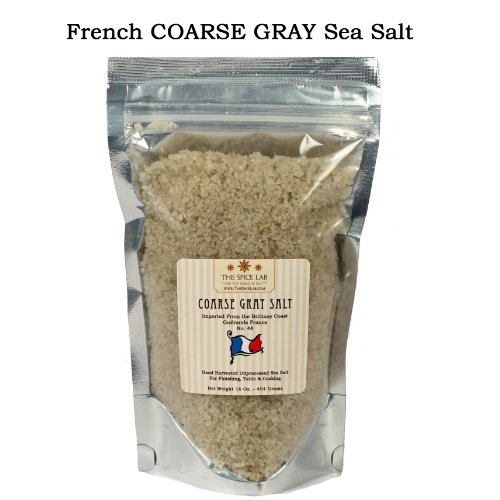
This “Sel Gris De Guérande” French Sea Salt has high marks on Amazon and comes in bags of various sizes.
Other Sea Salts
Alaea/Hawaiian Red
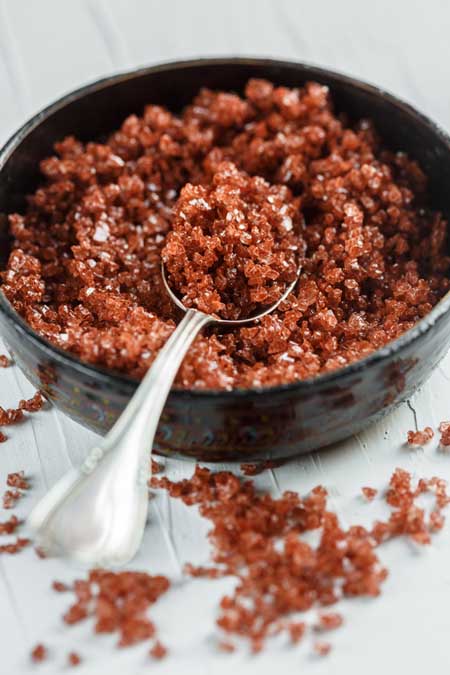
Alaea sea salt is a traditional table variety from Hawaii. It is used for seasoning and preserving. To enrich the substance with iron oxide, Alaea or volcanic baked red clay, is added.
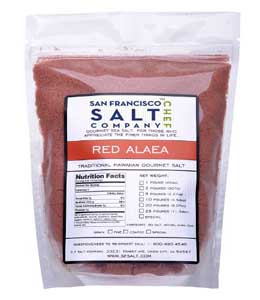
Foodal recommends this Hawaiian Red Alaea Sea Salt available from Amazon in fine or coarse, and in various sized packages.
The clay gives this variety an earthy flavor. It is used in traditional Hawaiian dishes, as well as on prime rib or pork dishes and it is available in fine or coarse grain.
Black Hawaiian

Black Hawaiian sea salt contains active charcoal, and is know for its detoxifying effects. It is great on salads, sushi, steak, chicken, and tofu. The pop of black color is stunning and will dress up any dish. This variety is available in coarse grain, to be used tableside and in grinders.
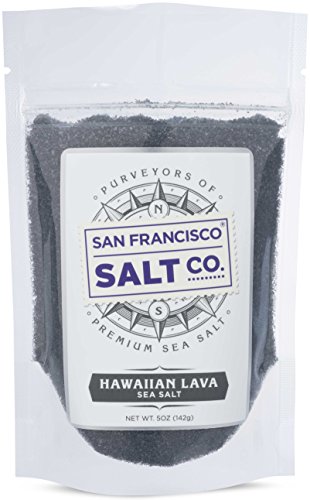
Hawaiian Black Lava Finishing Salt
Italian
Italian sea salt is harvested off the coast of Sicily in the Mediterranean. This unrefined white variety is rich in potassium and magnesium. Once the water in the salt pans has evaporated, the rough crystals are crushed, ground, and packaged.
Rich in flavor, this variety will enhance any food without being overly strong or salty. Finely ground Italian crystals can be added to virtually any dish, or the coarse variety works well as a fishing salt on roasts or in sauces.
ALESSI Fine Mediterranean Sea SaltIndian Black/Kala Namak
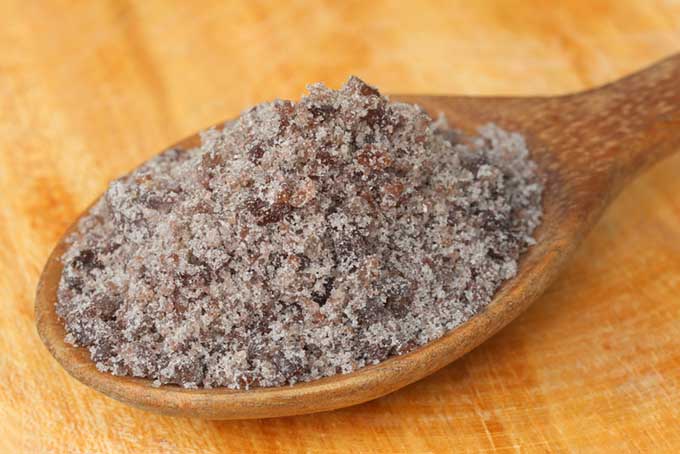
Indian black salt, also known as Kala Namak, is an unrefined mineral variety. The color is a pink-grey to pure pink, as opposed to black.
The strong sulfuric flavor and aroma is reminiscent of boiled eggs. Kala Namak is a common ingredient in authentic Indian dishes. This type can also be added to tofu scrambles, to add an egg flavor. It is available in fine or coarse grained varieties.
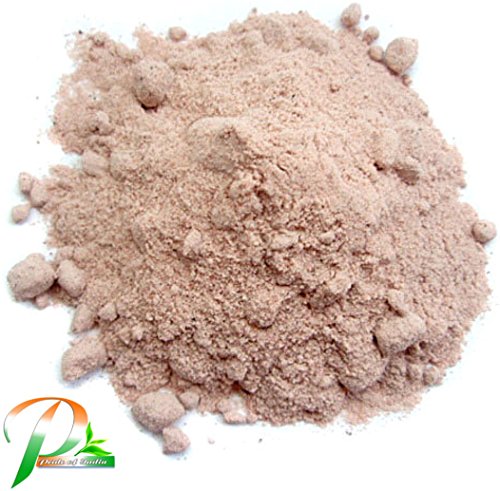
Pride Of India’ Kala Namak available on Amazon.
Himalayan Salt Blocks
Himalayan salt blocks are one of the latest kitchen trends. These slabs are cut from ancient deposits found in Pakistan. These blocks not only conduct heat throughout, but they enhance the flavor of your favorite foods. Simply place the block on top of your grill or stovetop to cook beef, chicken, fish, or vegetables.
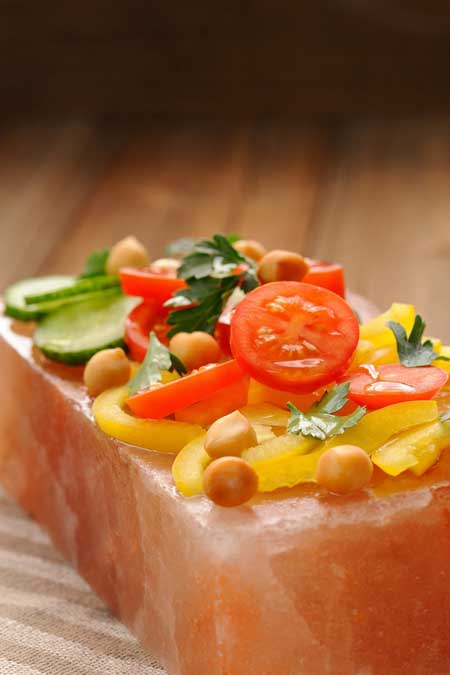
Chill to serve salads or sushi. Freeze and top with ice cream, caramel, or chocolate for an unexpectedly delicious dessert. These blocks are great for cooking or serving. In fact, you can purchase blocks shaped into bowls or cups for the perfect presentation.
Pink Himalayan features hues of red, pink and white, which is indicative of the mineral content, particularly iron oxide. With a crisp taste and less of a bite, it is the perfect finish to any soup, salad, or entree.

Sur La Table Himalayan Salt Block
Many of these blocks have not been allowed to fully cure after being mined, and they contain too much water. That is why we would recommend purchasing a premium brand such as the Sur La Table Himalayan Block pictured above. Too much heat can cause the cheaper ones to crack – or even worse – fly apart when heat is applied, since the trapped moisture needs to escape.
These blocks are naturally antimicrobial, just be sure to clean with a damp sponge or scrub brush once cooled. Allow the block to dry completely between uses.
There you have it. Everything you ever wanted (or needed) to know about salt. Now go out and use some of those flavors (sparingly) in your cooking today!
Looking for a place to keep all of that salt? Check out Foodal’s review of the best spice racks here.
What’s your favorite type of salt to season with? What do you use it for? Let us know in the comments!
About Jennifer Swartvagher
Jennifer is an experienced journalist and author. Her work has been featured on TODAY Parents, The New York Times Blog, BlogHer, Scary Mommy, and scores of other parenting and cooking publications.





Wow, I never knew there were so many types in the world. Here in Vietnam where I live, the most common kind used in daily cooking is basically sea salt mixed with some msg and finely grounded pepper in a whole packet.
I’ve only seen the Himalayan slabs on Iron Chef and they look absolutely fascinating. Does it season the food as you cook it? If so, how do you keep the food from becoming over-salted?
I was basically going to type the same comments. I had no clue that there were so many different varieties, but this was very interesting. I always learn something new on this blog. Now, I’m curious, and will of course have to try some of these other options.
I’m also curious about the slab. I was thinking the same thing. Do you just use it for a short amount of time and then finish cooking the food without it to prevent over salting? Hmmm. This is probably one that I won’t try any time soon, but it is still interesting to learn about it.
I always thought salt was just salt. Who knew there were as many kinds as there are common spices in the world? I’ve always been fond of salty dishes my whole life; I’ve got my blood pressure numbers to prove it to you. As long as you stay adequately hydrated, I don’t see the problem anyway.
I also thought salt is just salt…then you see this wide selection…that’s when you know you are spoilt for choice… i love salt…sometimes i put it in excess and i know i ought not to…
I read another article where they said in some areas… salt is harvested from tears…now that is pretty spooky… i never wanted to inquire whether the tears were from animals or human beings… lets leave it at that!
I’ll definitely look up… those two Foodal salt recommendations 🙂
I’ve never been a huge fan, but I do like a small amount of sea salt which I also use in the bath. Pink himalayan is supposed to be better for you, but while it does look pretty I’m not sure if it’s a placebo effect. Everyone needs some in the body and good quality natural product is worth it.
I have to say I knew a lot about the varieties that you mentioned already including Kosher.
My understanding of the term Kosher is that it refers to the size of grain that best allows salt to absorb blood from meat. If the grains are too small it does not absorb enough of the blood, if the grains are too large it absorbs all the blood, but also allows too much of the salt to leach back into the meat.
It is best referred to as koshering salt (the act of making the meat kosher) rather than Kosher which could also mean Kosher Certified (sorry a family member is Jewish).
On another note, it is interesting to read about the Italian kind being high in potassium and magnesium. I struggle to obtain enough potassium in my diet because of a medical condition and this product is not something I had heard about before. I shall have to look into the percentages. At the moment I am using Atlantic Grey Salt which doesn’t pass through a shaker very well because it is too wet, but I love it because it is not as salty in taste.
I had no clue there were so many! I honestly thought it was all the same except for size. The applewood smoked is already on my shopping list!
This has alerted me to the fact that I really need to up my salt game. That black lava kind looks amazing. I’m already thinking of recipes that would shine in. Well, it’s hard for black to shine so maybe that’s not the right word…
I grew up using regular iodized out of the ubiquitous Morton tube, but, because I love the stronger flavor, I often use sea salt, as well. I usually just use the disposable grinder, but, occasionally, I will eat a small chunk, just because I love the flavor.
I watch a lot of cooking shows, and have noticed they often use kosher salt. I’ve never seen/heard it explained on the shows, but since you mentioned that it’s purer, that is probably the reason. I’ve seen the Himalayan blocks, and would love to own one, one of these days. I do have a Himalayan salt lamp, and I just love the look and feel of it, regardless of whether or not it actually has healing properties. This article covers quite a few types that I’ve never heard of, and now I will have to try many of them. Thanks for covering the topic so thoroughly!
Here in the UK, we are always being advised to restrict our sodium intake so it’s rare to see all of these types in the stores. We usually have a choice of table, sea and kosher salts. Oh, and the substitutes, of course, but nothing like the variety I’ve just read about here. Some of them do sound really tasty so maybe a search on Amazon is in order!
I never knew salt came in so many colours, and types, and I had never considered that different types might work better with certain foods. Even if the flavour was the same and only colour and texture that differ, the right blend could add a very unique touch to a dish. After all how it looks does tend to affect how people think it tastes!
The article was very useful as I’ve had to pay a lot of attention to sodium levels in food recently. I hadn’t realised how hard it can be to try to get a product without iodine until I had to shop for someone with a thyroid problem. Like you missbishi,, I do wish we had a better range in the UK, since I’m having to head for a health food shop quite a way away, and can’t get anything but a few basic brands in the supermarket.
I’ve always cooked with regular, plain ol’ salt and I still do. My co-worker uses Himalayan sea salt as her primary source of salt in her cooking and she swears by it. I’ve only used it sparingly (mostly using some of hers when we eat lunch) and maybe it’s just me and my lame tastebuds, but I can’t really tell the difference!
I also wouldn’t know how to use the different type of salts if you just put them in front of me. I definitely want to expand my salt palate though, and hopefully with this post I can start doing that. Thank you!
Now this is an area I would like to explore. I started a few years back, experimenting with new seasonings, and it has been a wonderful journey. Exploring these salts, with their varied nuisances, would be fun. I like that they have the trace minerals and clays and lava, that are nutrient rich. It is like a whole new world of flavor! I don’t quite understand about the salt block, so I will just start with the salts.
That’s a pretty wide selection of salt there! I really like the fleur de sel on some breads from our local bakery — it’s delicious and delicate. As for iodine, it’s not really like iodine in sea salt would be somehow better from added iodine in table salt. Important is we get some, and that countries that don’t have access to enough iodine can get it in easy ways to prevent goiter. The concentrations are minimal, anyway — and so is the amount we need.
There is so much to take in and I will have to save this article for later. I love learning new information and you gave me a lot of different types of salts that I would like to try.
I love the kind that you can grind because the regular table variety is too crumbly and I just like using a grinder. I want to try the black Hawaiian since it looks tasty and it can be used on so many things. It also looks pretty.
The pink and red salts look cool too.
I think the bar salt is different. It seems like it would give a more even flavoring but also looks pricy. I would still like to give it a try though. I now have to show this to my mother.
I’m mostly familiar with sea salts (and good old Morton’s, of course) and fortunately for me, Hawaiian sea salts are easy to come by. But I still had no idea there were so many varieties. I don’t use very much salt in my cooking, truth be told, but in moderation it can make some dishes that much more delicious. Reminds me I’d like to try out some pink Himalayan sea salt.
Wow, you’ve covered a ridiculous number of salts here. I’ve personally tried… well, only the ones listed in the “Most common” section, haha. I have seen some of the finishing salts used on cooking shows before. I think the next time I’m feeling adventurous I’ll pick out a salt that matches a favorite meal, go buy it, and try it out. Starting one at a time and eventually I’ll make it through this whole list!
There’s something great about real salt and pepper. Unrefined and at its tastiness you can’t beat freshly ground salt used to season dishes, with the many different types of salt crystals now available the humble kitchen chef has another means to get unique flavours into meals. I particularly like the coarse pink salt crystals.
I am looking forward to trying the Black Hawaiian salt, it has been recommended and I am keen to sample the potential health benefits.
I have just bought a fab new Twist & Grind 2 in 1 salt and pepper grinder available exclusively on Amazon so what better way to try my new salt mill out?
Wow, this is a truly incredible post here. I had absolutely no idea that there were so many types of salts, but judging from the other comments I guess I wasn’t the only one who assumed that! In my mind, it has always been just salt, it was all the same. The only difference I knew before reading this was that there was normal table and then the bigger sea salt that you have to grind. Who knew there were so many varieties, or that it can be so pretty!? So much new information here, as always I appreciate you sharing your knowledge. I’d love to give some of these a try if I can find any of them locally.
I really loved learning about all of these different types! I truly never knew how many there were out there! In our home, we really love the Himalayan and Fleur De Sel. I’m really interested in trying the Indian and black varieties that you mentioned.
I can just imagine tat the Indian one is really good, and that it adds a curry-like flavor to the dish, which I would really enjoy. I could be wring, though, but this is just what immediately came to my mind. I hope that I can get to try them all, but that might tough.
Love all the in-depth information on the different types. I usually use plain sea salt but some of the other varieties sound interesting as well, especially the Hawaiian black variety. I also have the Indian black, kala namak, for adding to vegan “egg” dishes, like scrambled tofu and chickpea omelets, to give them a more authentic eggy taste. I’ll definitely need to get my hands on some new specialty salts when my current supplies run out.
I had no idea there were so many varieties in the world. I guess I just assumed that all of it was white and it was either refined or crunchy and course. The different colors make it real interesting and I am sure it must have different strengths. I love a little on my food, it just brings out the flavor that much more.
Oh my god, I can’t believe I never used any of those yet! I always pass them when I shop for groceries but it seems like they’re quite good for a variety of meals. Might have to pick up a couple!
Such an informative article on different salts. I have used a few of the ones you mentioned. I love Celtic Sea Salt. It has a wonderful taste. I want to try several more. I like the idea of healthy minerals. It’s nice to have options! Thanks for the article.
That black salt looks incredible! I would use it on everything if I got my hands on some of it. The only varieties I’d heard of on this list were the Himalayan and Kosher, all of the others were utter surprises to me. Once again, I have to say that I’m especially interested in the Hawaiian black type, it’s gorgeous and I’m sure the flavor is excellent. The red interests me as well.
I want to thank you for explaining how to use the salt slabs. I’ve seen them before and they really looked interesting, but didn’t fully grasp the concept. I also assumed they were more for restaurants and not for home cooks.
The Hawaiian Black Lava Salt looks incredible. I don’t think I’ve ever seen black salt before, I’ve seen many of the other varieties before, except that one. I think the next time I want to splurge on a seasoning in the kitchen, it will be for a purchase of this salt.
I love salt and the different types there are. I have a huge container of the ice cream version in my cabinet. I also recently bought some pink Himalayan from a specialty shop recently and plan to get some black lava. I’ve been looking for a good smoked version but I haven’t seen anything that’s peaked my interest yet. I need to keep looking around websites. That Apple-wood one looks wonderful. I might purchase it but I need to check out the reviews before I place an order. I had always thought Fleur de sel was just the French word for salt. I had no idea it was actually a type of it, and one of the highest grades at that. Now I need to get some. I’ve been using table and regular iodized but Fluer de sel sounds delectable. I definitely need to get the pink block. I can imagine grilling a whole fish on that block and I’m drooling just thinking about it.
I’ve always loved what various religions have done with food; finding new unique, and delectable, ways of making food taste great whist adhering to their dietary requirements. Kosher salt is just a fantastic example – it’s a new personal favorite – only if it was available in more areas so people can discover it’s unique tang.
Only this morning I was considering switching to a different kind of salt or at least buying one more kind when this piece showed up on my recommended articles! Very often I’ve come across recipes that require you to use sea salt but I have only ever kept regular table salt in my kitchen. Definitely going to have to expand the salt selection! I’d never heard of the Himalayas block salt before. It looks absolutely fascinating. I must try to get a hold of some.
Salt is fascinating and, as you say, we need it. I recently visited Guérande in Brittany and spent an afternoon on the salt flats and in a salt museum. The environment in which salt requires a delicate balance of elements in a certain sequence. Basically, they need high seas to fill the salt pans on the flats and then they need dry winds for the flowers to form.
Thanks for the helpful info on all of the different types of salts out there! I never knew that sea salt is harvested directly from the ocean and that it’s done using clay trays. That is really something I would like to learn about more because I think the natural processes we use to obtain salt are so fascinating! It makes me appreciate the things we have.
Very good informative article. Thanks for information.